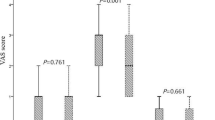Abstract
Background
Voiding cystourethrogram (VCUG) is a common procedure at pediatric tertiary care centres that can be painful as it involves a urinary catheter. Currently there are no widely utilized protocols for non-topical medications to decrease pain that children feel during catheterization.
Objective
To determine if intranasal (IN) fentanyl is effective at decreasing pain that children feel during catheterization of VCUG when compared with sterile water.
Materials and methods
We performed a double-blind randomized controlled trial, using IN fentanyl (2 μg/kg) compared to placebo (sterile water,) in children 4–8 years of age scheduled for elective VCUG in one urban pediatric tertiary center.
Results
Using the Face Pain Score-Revised, children receiving IN fentanyl scored 2.58 (1.93–3.25 95% CI) while those receiving sterile water scored 2.86 (2.20–3.51 95% CI) showing no statistically significant difference. There were no adverse events.
Conclusions
Although we were unable to show a statistically significant difference between our study and control groups, we believe that this may be due to technique (positioning, delivery device) and timing of administration of IN fentanyl as well as multi-factorial causes of distress during VCUG. Future studies investigating alternative delivery techniques of IN fentanyl for analgesia during VCUG may yield more promising results.
Similar content being viewed by others
References
Shaw KN, Gorelick M, McGowan KL et al (1998) Prevalence of urinary tract infection in febrile young children in the emergency department. Pediatrics 102:e16
Sargent MA (2000) What is the normal prevalence of vesicoureteral reflux? Pediatr Radiol 30:587–593
American Academy of Pediatrics (1999) Practice parameter: the diagnosis, treatment, and evaluation of the initial urinary tract infection in febrile infants and young children. Pediatrics 103:843–852
Merritt KA, Ornstein PA, Spicker B (1994) Children’s memory for a salient medical procedure: implications for testimony. Pediatrics 94:17–23
Galinkin J, Fazi L, Cuy R et al (2000) Use of intranasal fentanyl in children undergoing myringotomy and tube placement during halothane and sevoflurane anesthesia. Anesthesiology 93:1378–1383
Borland M, Jacobs I, Geelhoed G (2002) Intranasal fentanyl reduces acute pain in children in the emergency department: a safety and efficacy study. Emerg Med 14:275–280
Manjushree R, Lahiri A, Ghosh BR et al (2002) Intranasal fentanyl provides adequate postoperative analgesia in pediatric patients. Can J Anaesth 49:190–193
Streibel HW, Koenigs D, Kramer J (1992) Postoperative pain management by intranasal demand-adapted fentanyl titration. Anesthesiology 77:281–285
Toussaint S, Maidl J, Schwagmeier R et al (2000) Patient-controlled intranasal analgesia: effective alternative to intravenous PCA for postoperative pain relief. Can J Anaesth 47:299–302
Kennedy RM, Luhmann JD (1999) The “ouchless emergency department”. Getting closer: advances in decreasing distress during painful procedures in the emergency department. Pediatr Clin North Am 46:1215–1247
Golianu B, Krane EJ, Galloway KS et al (2000) Pediatric acute pain management. Pediatr Clin North Am 47:559–587
Hicks C, von Baeyer C, Spafford P et al (2001) The Face Pain Scale—Revised: toward a common metric in pediatric pain measurement. Pain 93:173–183
Zier JL, Drake GJ, McCormick PC et al (2007) Case-series of nurse-administered nitrous oxide for urinary catheterization in children. Anesth Analg 104:876–879
Zier JL, Kvam KA, Kurachek SC et al (2007) Sedation with nitrous oxide compared with no sedation during catheterization for urologic imaging in children. Pediatr Radiol 37:678–684
Bozkurt P, Kilic N, Kaya G et al (1996) The effects of intranasal midazolam on urodynamic studies in children. Br J Urol 78:282–286
Elder JS, Longenecker R (1995) Premedication with oral midazolam for voiding cystourethrography in children: safety and efficacy. AJR 164:1229–1232
Stokland E, Andréasson S, Jacobsson B et al (2003) Sedation with midazolam for voiding cystourethrography in children: a randomised double-blind study. Pediatr Radiol 33:247–249
Akil I, Ozkol M, Ikizoglu OY et al (2005) Premedication during micturating cystourethrogram to achieve sedation and anxiolysis. Pediatr Nephrol 20:1106–1110
Merguerian PA, Corbett ST, Cravero J (2006) Voiding ability using propofol sedation in children undergoing voiding cystourethrograms: a retrospective analysis. J Urol 176:299–302
Kogan A, Katz J, Efrat R et al (2002) Premedication with midazolam in young children: a comparison of four routes of administration. Paediatr Anaesth 12:685–689
Streibel HW, Pommerening J, Rieger A (1993) Intranasal fentanyl titration for postoperative pain management in an unselected population. Anaesthesia 48:753–757
Berde C, Wolfe J (2003) Pain, anxiety, distress and suffering: interrelated, but not interchangeable. J Pediatr 142:361–363
Stashinko E, Goldberger J (1998) Test or trauma? The voiding cystourethrogram experience of young children. Issues Compr Pediatr Nurs 21:85–96
Beyer JE (1984) The oucher: a user’s manual and technical report. The Hospital Play Equipment Company, Evanston
Author information
Authors and Affiliations
Corresponding author
Rights and permissions
About this article
Cite this article
Chung, S., Lim, R. & Goldman, R.D. Intranasal fentanyl versus placebo for pain in children during catheterization for voiding cystourethrography. Pediatr Radiol 40, 1236–1240 (2010). https://doi.org/10.1007/s00247-009-1521-1
Received:
Revised:
Accepted:
Published:
Issue Date:
DOI: https://doi.org/10.1007/s00247-009-1521-1




